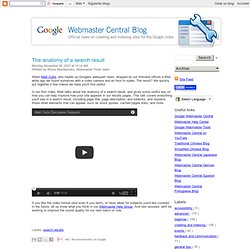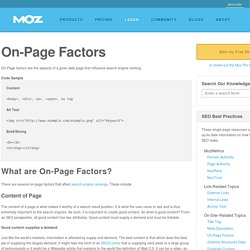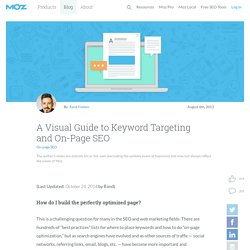

[Tuto] Les méta-balises. The anatomy of a search result. Written by Ríona MacNamara, Webmaster Tools team When Matt Cutts, who heads up Google's webspam team, dropped by our Kirkland offices a little while ago we found ourselves with a video camera and an hour to spare.

The result? We quickly put together a few videos we hope you'll find useful. In our first video, Matt talks about the anatomy of a search result, and gives some useful tips on how you can help improve how your site appears in our results pages. This talk covers everything you'll see in a search result, including page title, page description, and sitelinks, and explains those other elements that can appear, such as stock quotes, cached pages links, and more.
If you like the video format (and even if you don't), or have ideas for subjects you'd like covered in the future, let us know what you think in our Webmaster Help Group. On-Page Ranking Factors - SEO Best Practices. On-Page factors are the aspects of a given web page that influence search engine ranking.

Code Sample Content <body>, <div>, <p>, <span>, no tag Alt Text Bold/Strong What are On-Page Factors? There are several on-page factors that affect search engine rankings. Content of Page The content of a page is what makes it worthy of a search result position. Good content supplies a demand: Just like the world’s markets, information is affected by supply and demand. Good content is linkable: From an SEO perspective, there is no difference between the best and worst content on the Internet if it is not linkable. Title Tag Title tags are the second most important on-page factor for SEO, after content.
Along with smart internal linking, SEOs should make sure that the category hierarchy of the given website is reflected in URLs. The following is a good example of URL structure: The following is a bad example of URL structure: SEO Best Practice Title tag URL Content of page Image alt text External Resources. On-page-factors-perfect. A Visual Guide to Keyword Targeting and On-Page Optimization. (Last Updated: October 24, 2014 by Rand) How do I build the perfectly optimized page?

This is a challenging question for many in the SEO and web marketing fields. There are hundreds of "best practices" lists for where to place keywords and how to do "on-page optimization," but as search engines have evolved and as other sources of traffic — social networks, referring links, email, blogs, etc. — have become more important and interconnected, the very nature of what's "optimal" is up for debate. My perspective is certainly not gospel, but it's informed by years of experience, testing, failure, and learning alongside a lot of metrics from Moz's phenomenal data science team.
I don't think there's one absolute right way to optimize a page, but I do think I can share a lot about the architecture of how to target content and increase the likelihood that it will: larger version In the old days of SEO, "on-page optimization" referred merely to keyword placement. Larger version Uniquely valuable. Elements-optimized-lrg. Canonical Link Element.